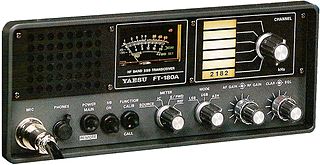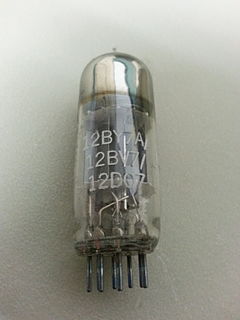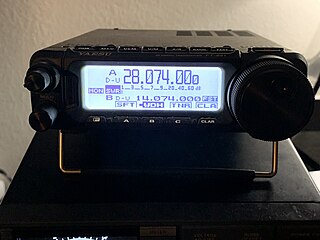
Citizens band radio, used in many countries, is a land mobile radio system, a system allowing short-distance person-to-many persons bidirectional voice communication among individuals, using two way radios operating on 40 channels near 27 MHz (11 m) in the high frequency band. Citizens band is distinct from other personal radio service allocations such as FRS, GMRS, MURS, UHF CB and the Amateur Radio Service. In many countries, CB operation does not require a license, and it may be used for business or personal communications. Like many other land mobile radio services, multiple radios in a local area share a single frequency channel, but only one can transmit at a time. The radio is normally in receive mode to receive transmissions of other radios on the channel; when users want to talk they press a "push to talk" button on their radio, which turns on their transmitter. Users on a channel must take turns talking. Transmitter power is limited to 4 watts in the US and the EU. CB radios have a range of about 3 miles (4.8 km) to 20 miles (32 km) depending on terrain, for line of sight communication; however, various radio propagation conditions may intermittently allow communication over much greater distances.

Heathkit is the brand name of kits and other electronic products produced and marketed by the Heath Company. The products over the decades have included electronic test equipment, high fidelity home audio equipment, television receivers, amateur radio equipment, robots, electronic ignition conversion modules for early model cars with point style ignitions, and the influential Heath H-8, H-89, and H-11 hobbyist computers, which were sold in kit form for assembly by the purchaser.

Yaesu, founded as Yaesu Musen Co., Ltd. in 1959 by a Japanese radio amateur Sako Hasegawa with call sign JA1MP in the Tokyo neighborhood of Yaesu, is a Japanese brand of commercial and amateur radio equipment.
The R. L. Drake Company is a manufacturer of electronic communications equipment located in Springboro, Ohio. It is also known for its line of equipment for amateur radio and shortwave listening, built in the 1950s through the 1980s. The company operates as a separate entity owned by Blonder Tongue Laboratories, Inc.
The 4-metre (70 MHz) band is an amateur radio band within the lower part of the very high frequency (VHF) band.
The FT-1000MP is an amateur radio ("ham") transceiver series, built by Yaesu. It is an "all-mode" set, operating in the high frequency (HF) frequency range. The "MP" suffix in the name was an homage to Sako Hasegawa, the late founder of the company whose callsign was JA1MP, and who heavily influenced the design and feature set built into this radio.

The "Wadley-drift-canceling-loop", also known as a "Wadley loop", is a system of two oscillators, a frequency synthesizer, and two frequency mixers in the radio-frequency signal path. The system was designed by Dr. Trevor Wadley in the 1940s in South Africa and the circuit was first used for a stable wavemeter.
Swan Electronics was a manufacturer of amateur radio gear located in Oceanside, California, United States.

The Hallicrafters SX-117 was a radio communications receiver manufactured by the Hallicrafters company in the 1960s.

.
The Yaesu FT-ONE is an all-mode solid state general coverage HF amateur radio (HAM) transceiver. The use of FM required an optional FM board to be installed. The unit was designed for fixed, portable or mobile operation, although the size and weight (17 kg) made it more suitable for fixed use. The FT-ONE was built by the Japanese Yaesu-Musen Corporation from 1982 to 1986. At its release, the FT-ONE was launched as the successor to the FT-902 and as the new Yaesu top-of-the-line transceiver. The FT-ONE was not only Yaesu's first fully synthesized, computer-controlled amateur band transceiver but it was also the first transceiver with a general coverage receiver. The FT-ONE was sold in the U.S., Asian and European markets. It was released in 1982 with a list price of $2800.00 US.

The Yaesu FT-817 is one of the smallest MF/HF/VHF/UHF multimode general-coverage amateur radio transceivers. The set is built by the Japanese Vertex Standard Corporation and is sold under the Yaesu brand. With internal battery pack, on board keyer, its all mode/all band capability and flexible antenna, the set is particularly well suited for portable use. The FT-817 is based on a similar circuit architecture as Yaesu's FT-857 and FT-897, so it is a compromise transceiver and incorporates its features to its low price.
The Yaesu FT-77 is a transceiver to be used in the 3,5 – 29,9 MHz shortwave radio amateur segment. This means the coverage of the 80-40-30-20-15-17-12 and 10 meter HF bands.
The Yaesu VX series is a line of two sequences of compact amateur radio handheld transceivers produced by Yaesu. There is a line of ultra-compact lower-power dual-band transceivers that started with the VX-1R and was later updated with the VX-2R and VX-3R. There is also a line of 5W tri-band transceivers that started with the VX-5R and was later updated with the VX-6R, VX-7R and VX-8R.

The 12BV7, 12BY7, 12BY7A, and equivalents were a class of medium-low gain, pentode vacuum tube amplifiers using the Noval socket configuration. Although originally marketed as pentode tubes for use in early television receivers, they found additional uses in audio and radiotelephone equipment. The series shares the EIA 9BF pinout with a number of other miniature pentode tubes of the era.
During World War II, the German Army relied on an diverse array of communications to maintain contact with its mobile forces and in particular with its armoured forces. Most of this equipment received the generic prefix FuG for Funkgerät, meaning "radio device". Occasionally the shorted Fu designation were used and there were exceptions to both these systems. Number ranges were not unique across the services so sometimes different equipment used by different services had the same FuG prefix. This article is a list and a description of the radio equipment.
The Yaesu FT-818 is one of a long line of FT-Series compact transceivers – the range of variations of the FT-Series 'ultra compacts' includes dual band multimode (VHF/UHF) through to the most recent variant, the FT-818ND, which is a MF/HF/VHF/UHF multimode general-coverage receiver and amateur radio transceiver. The set is built by the Japanese Yaesu Musen Co., Ltd. and was first available in March 2018. Whilst it may not be the smallest any more, in terms of what essentially is an old-school pure analogue design PLL synthesized conventional control arrangement transceiver, as opposed to most similar and more recent designs being mostly SDR aka software-defined radio transceiver types which are primarily digital circuitry and technology based, it is still essentially a very compact and very small true portable which is, as many owners of it and the 817 predecessor will confirm, literally as suited to man-pack type usage as easily as used shoulder slung as usable as a QRP transceiver transportable or simply as a base station QRP unit. Incorporating battery powered use via an internal nickel metal hydride type rechargeable battery pack and a substitutable AA type alkaline battery holder, an onboard keyer facility, the essentially (and fairly comprehensively when 'wide banded' fully, all analogue mode/all band Rx capability and in 'wide banded' form, close to Tx capable on almost every selectable band it supports, and a supplied tri-band three part flexible helical type antenna, the set is by general design particularly well suited for portable use and QRP use in general. The radio comes with the AA cell holder fitted from the factory, with the nickel hydride rechargeable pack reconfiguration a case of extracting the AA holder and unplugging it then plugging in and fitting the nickel hydride pack – no requirement to change any settings on the radio or move jumpers.

The Yaesu FT-891 is a HF + 6 meters all mode mobile amateur radio transceiver. The FT-891 was first announced to the public by Yaesu at the 2016 Dayton Hamvention. The radio has 100 watts output on CW, SSB, and FM modulations and 25 watts of output in AM. As a mobile transceiver the FT-891 is well suited for mobile installation in vehicles, and weighing less than 5 pounds it is often used for field activations such as Summits on the Air, and Parks on the Air. The radio has been praised for its noise reduction and sensitive receiver. Common criticisms of the radio include it's many menus that are difficult to navigate with its small screen, the lack of VHF/UHF capabilities, and lack of an internal antenna tuner. Although the radio lacks an internal sound card it still has input and output jacks for audio and be controlled over a USB cable allowing the radio to use digital modes such as WinLink, PSK31 and FT8.

The ICOM IC-7300 is a multimode 6 meter and HF base station amateur radio transceiver. The IC-7300 was announced to the public at the Japan Ham Fair in 2015. The radio has 100 watts output on CW, SSB, and FM modulations and 25 watts of output in AM. Although not the first SDR radio on the market The IC-7300 was the first mass-produced mainstream amateur radios to use SDR technology instead of the older superheterodyne transceiver design. Designed to replace the older IC-746PRO the IC-7300 is smaller and significantly lighter than its predecessor. Like many other radios of its class the IC-7300 has an internal antenna tuner and contains an internal audio card accessible over USB. This allows the radio to be used for popular digital modes such as PSK31, Winlink, and FT8. The radio has received praise for its easy to use menus, large readable screen, and excellent audio processing.











